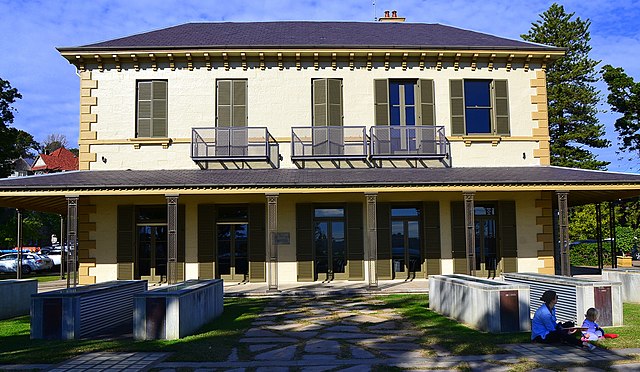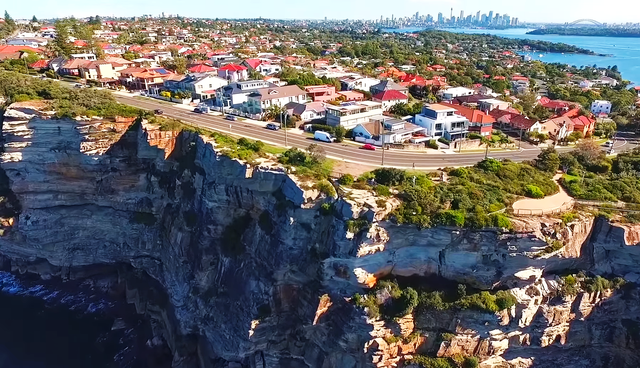Municipality of Woollahra
Local government area in New South Wales, Australia From Wikipedia, the free encyclopedia
Woollahra Municipal Council (or Woollahra Council) is a local government area in the eastern suburbs of Sydney, in the state of New South Wales, Australia. Woollahra is bounded by Sydney Harbour in the north, Waverley Council in the east, Randwick City in the south and the City of Sydney in the west.
| Woollahra Municipal Council New South Wales | |||||||||||||||
|---|---|---|---|---|---|---|---|---|---|---|---|---|---|---|---|
 Location in Metropolitan Sydney | |||||||||||||||
 | |||||||||||||||
| Coordinates | 33°53′S 151°15′E | ||||||||||||||
| Population | 53,496 (2021 census)[1] | ||||||||||||||
| • Density | 4,460/km2 (11,500/sq mi) | ||||||||||||||
| Established | April 1860 | ||||||||||||||
| Area | 12 km2 (4.6 sq mi) | ||||||||||||||
| Mayor | Sarah Swan | ||||||||||||||
| Council seat | Redleaf | ||||||||||||||
| Region | Metropolitan Sydney | ||||||||||||||
| State electorate(s) | |||||||||||||||
| Federal division(s) | Wentworth | ||||||||||||||
 | |||||||||||||||
| Website | Woollahra Municipal Council | ||||||||||||||
| |||||||||||||||


The administrative centre of Woollahra Municipal Council is located at Redleaf in Double Bay. The mayor of Woollahra Municipal Council is Cr. Sarah Swan.[2]
Suburbs in the local government area
Suburbs in the area include:
- Bellevue Hill
- Darling Point
- Double Bay
- Edgecliff
- Paddington (parts are located within City of Sydney Council)
- Point Piper
- Rose Bay (the east side of Old South Head Road is located within Waverley Council)
- Vaucluse (parts are located within Waverley Council)
- Watsons Bay
- Woollahra
Demographics
Summarize
Perspective
At the 2011 Census, there were 52,158 people in the Woollahra local government area, of these 47.1% were male and 52.9% were female. Aboriginal and Torres Strait Islander people made up 0.2% of the population. The median age of people in the Municipality of Woollahra was 38 years. Children aged 0 – 14 years made up 15.4% of the population and people aged 65 years and over made up 16.3% of the population. Of people in the area aged 15 years and over, 43.1% were married and 10.3% were either divorced or separated.[3]
Population growth in the Municipality of Woollahra between the 2001 Census and the 2006 Census was 0.70%; and in the subsequent five years to the 2011 Census, population growth was 3.98%. When compared with total population growth of Australia for the same periods, being 5.78% and 8.32% respectively, population growth in Woollahra local government area was significantly lower than the national average.[4] The median weekly income for residents within the Municipality of Woollahra was double the national average.[3][5]
At the 2016 Census, the proportion of residents who stated a religious affiliation with Judaism was in excess of thirty–two times the state and national averages.[6]
| Selected historical census data for Woollahra local government area | ||||||
|---|---|---|---|---|---|---|
| Census year | 2001[4] | 2006[5] | 2011[3] | 2016[6] | ||
| Population | Estimated residents on census night | 49,814 | ||||
| LGA rank in terms of size within New South Wales | 19th | |||||
| % of New South Wales population | 1.90% | |||||
| % of Australian population | 0.26% | |||||
| Cultural and language diversity | ||||||
| Ancestry, top responses | English | 23.6% | ||||
| Australian | 17.7% | |||||
| Irish | 9.0% | |||||
| Scottish | 6.9% | |||||
| Chinese | n/c | |||||
| Language, top responses (other than English) | Mandarin | n/c | n/c | |||
| French | 1.0% | |||||
| Greek | 1.4% | |||||
| Spanish | n/c | |||||
| Italian | 1.2% | |||||
| Religious affiliation | ||||||
| Religious affiliation, top responses | No religion | 15.1% | ||||
| Catholic | 19.9% | |||||
| Anglican | 21.2% | |||||
| Judaism | 13.4% | |||||
| Not stated | n/c | |||||
| Median weekly incomes | ||||||
| Personal income | Median weekly personal income | A$976 | A$1,145 | A$1,365 | ||
| % of Australian median income | 209.4% | |||||
| Family income | Median weekly family income | A$1,917 | A$2,832 | A$3,626 | ||
| % of Australian median income | 186.7% | |||||
| Household income | Median weekly household income | A$2,654 | A$2,398 | A$2,687 | ||
| % of Australian median income | 226.6% | |||||
Council
Summarize
Perspective
Woollahra Municipal Council is composed of fifteen councillors elected proportionally as five separate wards, each electing three Councillors. Councillors are usually elected for a fixed four-year term of office.[7] The Mayor is elected by the Councillors at the first meeting of the council. The Council election of 14 September 2024 resulted in the following makeup:[8][9][10][11][12]
Current composition and election method

| Party | Councillors | |
|---|---|---|
| Liberal Party | 9 | |
| Residents First Woollahra | 5 | |
| The Greens | 2 | |
| Total | 15 | |
The council as elected in 2024, in order of election by ward, was:
| Ward | Councillor | Party | Notes | |
|---|---|---|---|---|
| Bellevue Hill Ward[13] | Sean Carmichael | Liberal | Deputy Mayor 2024–present | |
| Lucinda Regan | Residents First Woollahra | |||
| Hugh Woodgate | Liberal | |||
| Cooper Ward[14] | Sarah Swan | Liberal | Mayor 2024–present
Deputy Mayor 2023–2024 | |
| Jeanette Mitchell | Liberal | |||
| Torsten Blackwood | Residents First Woollahra | |||
| Double Bay Ward[15] | Toni Zeltzer | Liberal | Deputy Mayor 2011–2012; Mayor 2013–2017. | |
| Mark Silcocks | Residents First | |||
| James Ardouin | Liberal | |||
| Paddington Ward[16] | Alex Andruska | Liberal | ||
| Harriet Price | Residents First | |||
| Matthew Robertson | The Greens | |||
| Vaucluse Ward[17] | Mary-Lou Jarvis OAM | Liberal | Deputy Mayor 2018–2019. | |
| Merrill Halkerston Witt | Residents First | |||
| Julian Parmegiani | Liberal | |||
Election results
2024
| Party | Votes | % | Swing | Seats | Change | ||
|---|---|---|---|---|---|---|---|
| Liberal | 16,143 | 57.0 | 8 | ||||
| Residents First Woollahra | 9,393 | 33.0 | 5 | ||||
| Greens | 2,769 | 9.0 | 1 | ||||
| Formal votes | 28,305 | 96.0 | |||||
| Informal votes | 1,039 | 3.0 | |||||
| Total | 29,344 | 73.0 | 15 | ||||
| Registered voters | 40,179 | ||||||
History of Woollahra
Summarize
Perspective
The name 'Woollahra' is thought to be derived from an Aboriginal word meaning 'camp' or 'meeting ground'.[20]
A petition was submitted in 1859 with 144 signatures of local residents from Darling Point, Paddington and Watsons Bay for the formation of the Municipality. With no petition against formation of the Municipality, Woollahra was proclaimed to be named so on 17 April 1860, and gazetted on 20 April 1860. At the first meeting, The Hon. George Thornton was elected as the first Chairman of Woollahra.[20]
In 1947, after previously acquiring 'Iron House' on Ocean Street, in the 1860s, Council transferred to the current site at Redleaf.[20]
Woollahra largely developed as a residential locality. A few small local industries were established in Woollahra, Double Bay and Paddington; but with the residential gentrification of Paddington and Woollahra in the 1960s, most of these cottage industries had vanished by the end of the 20th century.[citation needed]
Woollahra's cultural heritage has been enriched by the influx of people from many different cultural backgrounds. Some of the influential immigrants to Woollahra have been the Chinese market gardeners, who began leasing land in Double Bay gully and Rose Bay in the 1880s; the Portuguese whalers who settled at Watsons Bay in the 19th century, building a church and becoming a part of the village life, and the many Europeans who migrated after World War II and helped change the face of commercial centres such as Double Bay.[citation needed]
A 2015 review of local government boundaries recommended that the Municipality of Woollahra merge with the Waverley and Randwick councils to form a new council with an area of 58 square kilometres (22 sq mi) and support a population of approximately 274,000.[21] Following an independent review, in May 2016 the NSW Government sought to dismiss the council and force its amalgamation with Waverley and Randwick councils. Woollahra Council instigated legal action claiming that there was procedural unfairness and that a KPMG report at the centre of merger proposals had been "misleading". The matter was heard before the NSW Court of Appeal who, in December 2016, unanimously dismissed the council's appeal, finding no merit in its arguments that the proposed merger with its neighbouring councils was invalid.[22] In July 2017, the Berejiklian government decided to abandon the forced merger of the Woollahra, Waverley and Randwick local government areas, along with several other proposed forced mergers.[23]
Heritage listings
Summarize
Perspective
The Municipality of Woollahra has a number of heritage-listed sites, including:
- Bellevue Hill, 24 Victoria Road: Leura[24]
- Darling Point, 1a Carthona Avenue: Lindesay[25]
- Darling Point, 68 Darling Point Road: The Swifts[26]
- Darling Point, 103 Darling Point Road: Babworth House[27]
- Darling Point, 11–21 Greenoaks Avenue: Bishopscourt[28]
- Double Bay, Cross Street: Double Bay Compressed Air Ejector Station[29]
- Double Bay, 11 Gladswood Gardens: Gladswood House[30]
- Double Bay, 337–347 New South Head Road: Overthorpe[31]
- Double Bay, 560 New South Head Road: Fairwater[32]
- Double Bay, 4 and 6 Wiston Gardens: Houses[33]
- Edgecliff, 8 Albert Street: Fenton and surrounds[34]
- Paddington, 1 Ormond Street: Juniper Hall, Paddington[35]
- Paddington, 56a Ormond Street: Engehurst[36]
- Paddington, 246 Oxford Street: Paddington Post Office[37][38][39]
- Paddington, 1 Young Street: Paddington Substation[40]
- Point Piper, 10 Dunara Gardens: Dunara[41]
- Rose Bay, 3–4 Fernleigh Gardens: Site of Ficus superba var. henneana tree[42]
- Rose Bay, 1–7 Salisbury Road: Salisbury Court (Rose Bay)[43]
- Vaucluse, 32b Fitzwilliam Road: Wentworth Memorial Church[44]
- Vaucluse, Chapel Road: Wentworth Mausoleum[45]
- Vaucluse, Greycliffe Avenue: Nielsen Park[46]
- Vaucluse, Old South Head Road: Macquarie Lighthouse[47]
- Vaucluse, 52 Vaucluse Road: Strickland House, Vaucluse[48]
- Vaucluse, 69a Wentworth Road: Vaucluse House[49]
- Watsons Bay, Dunbar (ship)[50]
- Watsons Bay, Old South Head Road: Hornby Lighthouse[51]
- Woollahra, 14 Rosemont Avenue: Rosemont[52]
- Woollahra, Waimea Avenue: Waimea House[53]
Coat of arms
|
See also
References
External links
Wikiwand - on
Seamless Wikipedia browsing. On steroids.
